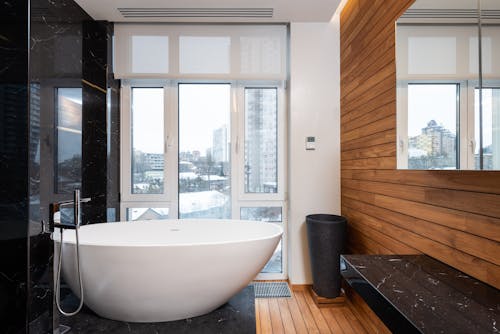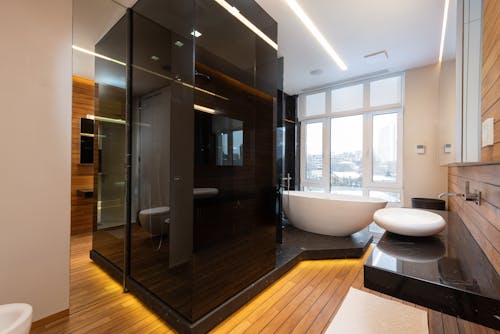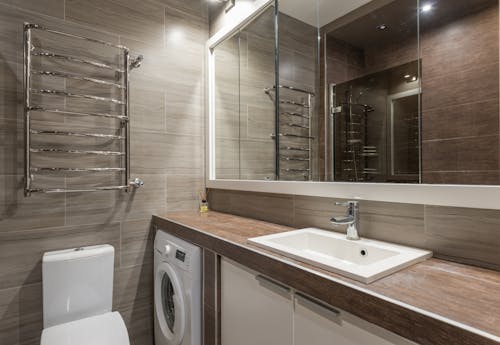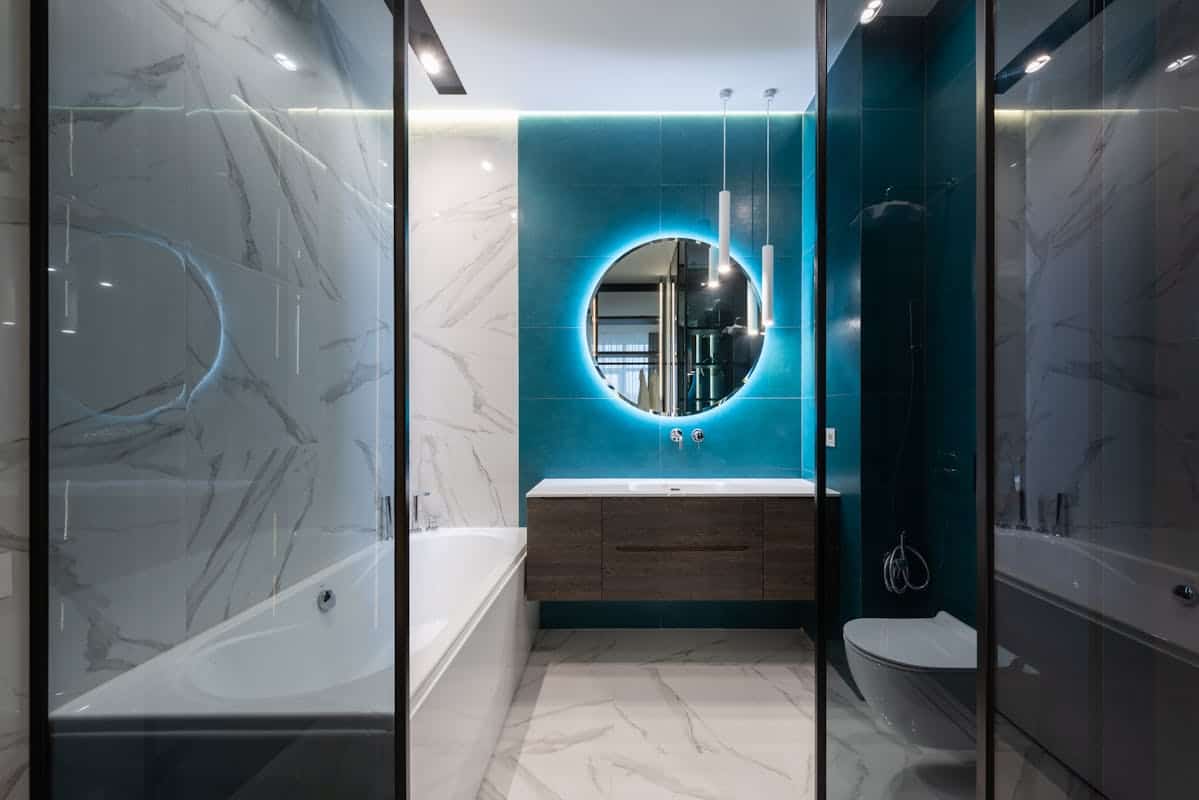When it comes to designing a bathroom that accommodates the needs of seniors, the concept of “Aging-in-Place Bathroom Design” is crucial.
This design approach focuses on creating a safe and comfortable space for older adults to use independently.
By integrating specific features and considerations, you can ensure that your bathroom remains functional, stylish, and easy to navigate as you or your loved ones age.
In this blog post, we will explore the key elements of it and provide you with the top tips for achieving success in creating a senior-friendly bathroom.
Table of Contents
Design Elements for Aging-in-Place Bathroom

Designing an aging-in-place bathroom requires thoughtful consideration of various elements to promote safety, accessibility, and convenience. Here are some essential design elements to incorporate:
Grab Bars
One of the most crucial elements in any aging-in-place bathroom design is the strategic installation of grab bars. These sturdy metal bars provide essential support and stability for seniors, helping them navigate the bathroom safely and independently.
Incorporating grab bars in key areas of the aging-in-place bathroom significantly reduces the risk of falls and injuries. Here’s how grab bars play a vital role in this design philosophy:
- Enhanced Toilet Safety: Installing grab bars on both sides of the toilet, ideally one near the wall and another near the toilet paper holder, provides crucial support for sitting down, standing up, and transferring to and from mobility aids like walkers or wheelchairs.
- Shower Confidence: Grab bars inside the shower stall are essential for maintaining balance and preventing slips on wet surfaces. Installing a horizontal grab bar near the shower controls and a vertical grab bar near the shower seat or bathing area offers support when entering, showering, and exiting.
- Bathtub Accessibility: Grab bars near the bathtub entrance and on the bathtub wall next to the faucet or showerhead to increase safety during bathing. Additionally, a grab bar strategically placed outside the bathtub can assist with safely stepping out after a bath.
Grab bars help seniors using the aging-in-place restroom feel more independent and self-assured in addition to offering them with physical support. The knowledge that dependable handholds are easily accessible can reduce their anxiety and give them more confidence to handle the restroom routine on their own.
Remember that grab bars are available in a variety of shapes, sizes, and finishes to complement your bathroom’s decor. For your aging-in-place bathroom, getting advice from a licensed contractor or occupational therapist can assist establish the best location and design for grab bars to guarantee maximum safety and functionality.
Non-Slip Flooring
One of the most crucial considerations in creating a safe and functional Aging-in-Place Bathroom is the flooring. Slippery surfaces pose a significant risk for falls, especially for older adults with reduced mobility. Therefore, prioritizing non-slip flooring throughout your bathroom is an essential element of Aging-in-Place Bathroom Design.
Here’s why non-slip flooring is critical in an Aging-in-Place Bathroom:
- Reduced Fall Risk: Stepping out of a shower or bathtub onto a wet floor can be treacherous. Non-slip flooring provides increased traction, significantly reducing the risk of slips and falls, which can lead to serious injuries for older adults.
- Confidence and Independence: Knowing the bathroom floor is secure can provide older adults with a sense of confidence and independence. This allows them to navigate the bathroom safely and maintain their daily routines without fear of falling.
- Peace of Mind for Everyone: Non-slip flooring offers peace of mind for both older adults and their families. Knowing the bathroom environment is safe and minimizes fall risks allows everyone to relax and enjoy a worry-free space.
Choosing the Right Non-Slip Flooring:
There are a variety of non-slip flooring options available for Aging-in-Place Bathroom Design. Here are some popular choices:
- Textured Ceramic or Porcelain Tile: These tiles offer a classic look and come with a variety of textures that provide excellent slip resistance.
- Vinyl Flooring: Vinyl flooring is a budget-friendly option that comes in a wide range of styles and textures, including non-slip varieties specifically designed for bathrooms.
- Rubber Flooring: Rubber flooring is highly slip-resistant, comfortable underfoot, and can be a good choice for areas around the shower or bathtub.
- Cork Flooring: While not as common as other options, cork flooring offers a naturally warm and slip-resistant surface, making Aging-in-Place Bathroom Design a good choice for Aging-in-Place Bathrooms.
By prioritizing non-slip flooring throughout the Aging-in-Place Bathroom Design, you’re creating a safer and more functional space for older adults to navigate with confidence and independence.
Walk-In Shower
One of the most crucial elements in any successful aging-in-place bathroom design is the walk-in shower. Traditional bathtubs with high walls and slippery surfaces can pose a significant safety risk for older adults. Walk-in showers, on the other hand, offer a safer and more accessible alternative, promoting independence and confidence for users with varying levels of mobility.
Benefits of Walk-In Showers in Aging-in-Place Design:
- Enhanced Safety: Walk-in showers eliminate the need to step over a high threshold, a major tripping hazard for seniors. This significantly reduces the risk of falls, a leading cause of injuries in older adults.
- Improved Accessibility: A curbless or low-curb entry allows for easy access, even for those using wheelchairs or walkers. Grab bars strategically placed around the shower walls provide additional support and stability while showering.
- Comfort and Convenience: Walk-in showers often offer more space than traditional tubs, allowing for greater freedom of movement. The inclusion of a built-in shower seat creates a comfortable place to rest while showering, promoting a sense of independence and safety.
- Flexibility: Walk-in showers can be customized to meet individual needs. Hand-held showerheads provide greater control and flexibility for users with limited mobility. Showerheads can also be installed at adjustable heights for added comfort.
By incorporating a walk-in shower into the Aging-in-Place Bathroom Design, you’re not just creating a safer space; you’re promoting long-term independence and well-being for yourself or your loved ones. It’s an investment that fosters confidence and dignity for users while offering peace of mind to caregivers.
Adjustable Showerheads
Creating a secure and cozy showering experience is crucial for any bathroom designed for older adults. Traditional fixed bathtubs can be difficult for people who are not very mobile or skilled. Showerheads with changes become really useful in this situation.
Unlike their fixed counterparts, adjustable showerheads offer the flexibility to change the height and angle of the spray. This allows users to find a comfortable showering position, regardless of their physical limitations. For example, someone with limited upper body strength can adjust the showerhead to a lower position, eliminating the need to reach overhead. Alternatively, a person using a shower chair can adjust the angle of the spray for optimal coverage while seated.
Several adjustable showerhead options exist to cater to different needs in an aging-in-place bathroom:
- Slide Bar Mount: These models attach to a vertical slide bar, allowing the user to adjust the showerhead height easily.
- Angle Adjustment: These showerheads can be tilted at various angles to direct the water flow for a more comfortable showering experience.
- Handheld with Slide Bar: This versatile option combines a handheld showerhead with a slide bar for height adjustment. The handheld feature allows for greater control over the water flow and easy rinsing of hard-to-reach areas.
By incorporating adjustable showerheads into your aging-in-place bathroom design, you promote safety, independence, and overall comfort for users with varying abilities. This simple yet effective design element can make a world of difference in creating a bathroom that is truly functional and enjoyable for everyone throughout their lives.pen_sparktunesharemore_vert
Top Tips for Successful Aging-in-Place Bathroom Design

To ensure a successful aging-in-place bathroom design, follow these top tips:
Prioritize Safety
The foundation of an effective aging-in-place bathroom design is safety. Our movement and balance might gradually decline with age, making even simple bathroom functions like taking a shower or using the restroom potentially dangerous. An aging-in-place bathroom puts safety first by including elements that reduce the chance of accidents and falls, enabling you to keep your independence and comfortably live in your own house for as long as possible.
Here are some key safety features to consider in your aging-in-place bathroom design:
- Strategic Grab Bars: Install sturdy grab bars near the toilet, bathtub, and shower. These bars provide essential support for getting in and out of these areas, enhancing stability and reducing the risk of falls. Consider bars with a secure grip and a diameter that’s easy to grasp for individuals with limited hand strength.
- Slip-Resistant Flooring: Wet surfaces in the bathroom pose a significant fall risk. Opt for slip-resistant flooring throughout the bathroom, especially in the shower and bathtub areas. Look for tiles with a textured surface, vinyl flooring with a high coefficient of friction, or rubber mats. Avoid smooth surfaces like polished stone or glazed ceramic tiles, which can become slippery when wet.
- Adequate Lighting: Good lighting is crucial for safety in an aging-in-place bathroom. Install bright overhead lighting that illuminates the entire space. Additionally, consider task lighting near the sink and vanity for better visibility during grooming and personal hygiene tasks. Nightlights can also help provide a soft glow and prevent nighttime stumbles.
You can design an aging-in-place bathroom that encourages independence, lowers the chance of accidents, and gives you the confidence and peace of mind to enjoy your bathroom. All by adding these safety elements.
Consider Accessibility
A key consideration in successful aging-in-place bathroom design is ensuring easy accessibility for seniors. This not only promotes independence but also minimizes the risk of falls and injuries. Here’s how you can incorporate accessibility features into your aging-in-place bathroom design:
- Doorways: Standard doorways might pose a challenge for individuals using wheelchairs or walkers. In an aging-in-place bathroom design, consider widening doorways to at least 32 inches to allow for easy maneuvering of mobility aids.
- Maneuvering Space: Clear floor space around fixtures like the toilet, shower, and sink is crucial. Ensure there’s enough room for someone using a walker or wheelchair to comfortably approach, turn around, and transfer safely.
- Faucets and Controls: Traditional knob-style faucets can be difficult for seniors with limited grip strength to operate. Opt for lever-handled faucets that are easier to turn on and off with minimal hand strength.
- Shower Accessibility: A standard bathtub can be a safety hazard for seniors. Consider replacing it with a walk-in shower with a low curb or no curb at all. Installing a shower seat and a handheld showerhead provides additional comfort and support during showering.
- Toilet Height: Standard toilets can be too low for some seniors, making sitting and standing difficult. Incorporate comfort-height toilets that are several inches taller for easier use.
- Grab Bars: Strategically placed grab bars near the toilet, shower, and bathtub are essential for providing support and stability when entering, exiting, or transferring.
You may build an aging-in-place bathroom that is secure, comfortable, and encourages adults to maintain their independence as they age by adding these accessible features. Remember that they may carry out their everyday activities with respect for their privacy while using an accessible bathroom that is carefully built.
Maximize Comfort

Comfort is paramount in any bathroom, but it becomes especially crucial in aging-in-place design. A well-designed aging-in-place bathroom should not only be safe and functional but also provide a sense of ease and relaxation. Here’s how you can incorporate features that maximize comfort in your aging-in-place bathroom:
- Built-in Shower Seating: Standing for long periods can become difficult with age. Installing a built-in shower seat allows users to rest comfortably during showering, promoting safety and reducing fatigue. Look for seats that fold up when not in use, maximizing space in the shower stall.
- Adjustable Showerheads: A fixed showerhead can be limiting, especially for those with restricted mobility. The aging-in-place design incorporates adjustable showerheads that can be raised or lowered depending on the user’s needs. This allows for a more comfortable showering experience while seated or standing.
- Temperature-Controlled Faucets: Scalding is a risk for anyone, but especially for older adults with reduced sensitivity. Temperature-controlled faucets with clear markings and lever handles are a must-have in an aging-in-place bathroom. These faucets allow for easy control of water temperature, preventing accidental scalding and ensuring a comfortable bathing experience.
- Grab Bars with Padding: Grab bars provide essential support in an aging-in-place bathroom, but comfort shouldn’t be sacrificed for safety. Opt for grab bars with a padded or textured surface for a more secure and comfortable grip. Strategically place grab bars around the bathtub, shower, and toilet to assist with entering, exiting, and maneuvering safely.
- Spacious Walk-In Showers: Replacing a bathtub with a spacious walk-in shower is a popular choice for aging-in-place design. This eliminates the need to step over a high threshold, reducing the risk of falls. Walk-in showers also provide ample space for maneuvering and using bathing aids like shower chairs or stools.
By incorporating these comfort-enhancing features, your aging-in-place bathroom won’t just be functional, it will be a relaxing and enjoyable space for users of all ages and abilities. Remember, a comfortable bathroom promotes independence and dignity for older adults, allowing them to maintain their daily routines with confidence.
Embrace Stylish Solutions
It’s frequently thought that when designing bathrooms for older individuals, comfort must come at the cost of beauty. But that isn’t at all true!It is absolutely possible to create a lovely and functional setting with careful planning. The key is to use stylish solutions that skillfully combine high-end design with safety features.
When designing a bathroom for the senior population, you have countless stylish and practical options at the ready. For example, modern fixtures can offer both style and security. Frameless glass doors for walk-in showers are a modern and stylish design choice.These showers not only remove the need to cross borders, but they also provide an air of openness and spaciousness.Grab bars are a classy addition that come in a variety of finishes to match the bathroom accessories you’ve selected.
When it comes to accessories, functionality doesn’t have to be boring. Search for shower seats with elegant lines, luxurious padding, and overall design harmony. Adding grab bars to high toilet seats increases the look and comfort. Remember that small things like strategically placed towel racks and cabinets can enhance both the overall look and accessibility of your aging-in-place bathroom.
If design and functionality are given equal weight, it is possible to create an aging-in-place bathroom that is not only safe and comfortable but also visually beautiful.This can ensure a space you love to use for many years to come, no matter how old you get or how mobile you get.
By following these tips, you may create an aging-in-place bathroom that successfully integrates safety, comfort, accessibility, and style.
Conclusion
In conclusion, designing an aging-in-place bathroom is a practical and essential step for seniors looking to maintain independence and safety at home. By incorporating key design elements and following the top tips for success, you can transform your bathroom into a space that meets your needs as you age gracefully.
If you’re considering updating your bathroom with aging-in-place design features, now is the perfect time to start. Remember, a well-designed bathroom can make a significant difference in your daily routine and overall quality of life.
Start planning your aging-in-place bathroom design today and create a space that enhances your well-being for years to come.
What are the most important considerations for an aging-in-place bathroom?
Safety and accessibility are paramount. This means installing grab bars, non-slip flooring, and a curbless shower or walk-in tub. Consider features like raised toilet seats, adjustable showerheads, and strategically placed storage for easy reach.
How can I make my aging-in-place bathroom stylish and functional?
Incorporate universal design principles that cater to all ages and abilities. Choose timeless finishes and fixtures that complement your existing decor. Opt for open shelving and well-lit spaces for improved visibility.
What are some affordable aging-in-place bathroom DEsign modifications?
Installing grab bars near the toilet and shower is a cost-effective way to enhance safety. Adding a shower seat or hand-held showerhead increases accessibility. Consider replacing doorknobs with levers for easier grip.
How can I involve family members in the aging-in-place bathroom design process?
Collaborate with family members to understand their needs and preferences. Encourage their participation in choosing materials, fixtures, and overall design aesthetic. This fosters a sense of ownership and ensures the bathroom meets everyone’s expectations.
Where can I find resources and inspiration for aging-in-place bathroom design?
Consult with aging-in-place specialists, occupational therapists, and bathroom remodeling professionals. Explore online resources and design galleries for ideas. Visit local showrooms to experience products firsthand.
What are some common mistakes to avoid in aging-in-place bathroom design?
Overlooking safety features like grab bars and non-slip flooring. Choosing fixtures that are difficult to operate or reach. Neglecting storage solutions for easy access to essential items. Failing to consider future needs and potential mobility limitations.
How can I ensure my aging-in-place bathroom is future-proof?
Choose adaptable features like adjustable showerheads and grab bars that can be easily repositioned. Opt for durable materials that require minimal maintenance. Consider incorporating smart home technology for added convenience and safety.
What are some innovative aging-in-place bathroom products I should consider?
Voice-activated mirrors for hands-free operation. Heated towel racks for added comfort. Walk-in bathtubs with built-in seats and hydrotherapy features. Smart toilets with bidet functions and automatic flushing.

